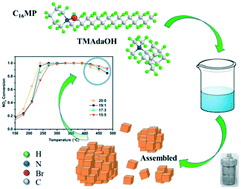Dual-template assembled hierarchical Cu-SSZ-13: morphology evolution, crystal growth and stable high-temperature selective catalytic reduction performance†
Abstract
It is crucial to determine the role and function of the mesopores in porous zeolite catalysis for NH3-SCR. Herein, a pore-controllable hierarchical Cu-SSZ-13 was assembled using a dual-template combining N,N,N-trimethyl-1-adamantammonium hydroxide (TMAdaOH) as the structure-directing agent with C16H33-[N+-methylpiperidine] (C16MP) as the mesoporogen. The introduction of C16MP drives the transition of the morphology of SSZ-13 from layered stacking to blocky stacking based on the arrangement of organic and inorganic species in the crystallization gel. Meanwhile, two different dimensions of mesopores are created by controlling the concentration of C16MP. During the induction and early crystallization stage, amorphous porous material dissolves and recrystallizes into CHA nuclei, followed by the conversion of partial mesopores to micropores. With increasing C16MP, the amount of 4Si species in the hierarchical Cu-SSZ-13 increased while the Si/Al ratio was unchanged, suggesting that the aluminum distribution may be regulated by mesoporogen. The interaction between micropores and mesopores improves the adsorption of NO and NH3. Above 400 °C, the presence of mesopores reduced the catalyst activity from 16% to 8% compared with micro-SSZ-13 and also maintained a high temperature activity.



 Please wait while we load your content...
Please wait while we load your content...